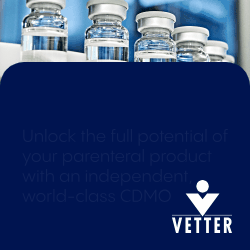Bio Platforms
Lexicon Announces Patient-Reported Data on Diabetic Peripheral Neuropathic Pain
Lexicon Pharmaceuticals, Inc. recently announced data from a study of patients describing the impact of diabetic peripheral neuropathic pain (DPNP) despite treatment with standard of…
Lisata Therapeutics & WARPNINE Announce iLSTA Trial Enrollment Completion & Provide Preliminary Data Update
Lisata Therapeutics, Inc. and WARPNINE Incorporated recently announced the successful completion of patient enrollment in the Phase 1b/2a iLSTA trial (ACTRN12623000223639) in Australia. The study…
Genascence Announces FDA Grants Regenerative Medicine Advanced Therapy Designation to GNSC-001 for Knee Osteoarthritis
Genascence Corporation recently announced the US FDA has granted the Regenerative Medicine Advanced Therapy (RMAT) designation to GNSC-001, a potential first-in-class gene therapy blocking interleukin…
Quetzal Therapeutics Debuts With Expert Leadership, High-Impact Pipeline & $50 Million of Committed Capital
Quetzal Therapeutics, a newly formed biopharmaceutical company, announced its official launch today with $50 million of committed capital. Founded to address urgent unmet needs in…
Amphista Therapeutics Announces Research Milestone in its Collaboration With Merck Triggering Milestone Payment
Amphista Therapeutics recently announced the successful achievement of a discovery research milestone under its exclusive research collaboration and license agreement with Merck. In conjunction with…
Oragenics, Announces US-Based Drug Manufacturing Agreement to Support ONP-002 Clinical Development
Oragenics, Inc. rrecently announced it has entered into a manufacturing agreement with Sterling Pharma Solutions, an industry leading CDMO with multiple US-based development and manufacturing…
Acumen Pharmaceuticals & JCR Pharmaceuticals Enter Strategic Collaboration, Option & License Agreement to Develop Enhanced Brain Delivery Therapy for Alzheimer’s Disease
Acumen Pharmaceuticals, Inc. recently announced a collaboration, option, and license agreement with JCR Pharmaceuticals to develop an oligomer-targeted Enhanced Brain Delivery (EBD) therapy for Alzheimer’s…
BriaCell Adds Mayo Clinic to Phase 3 Study in Metastatic Breast Cancer
BriaCell Therapeutics Corp. recently announced the addition of a key clinical site, Mayo Clinic, to its ongoing pivotal Phase 3 clinical study (ClinicalTrials.gov as NCT06072612)…
AAVantgarde Receives FDA Clearance to Progress Stargardt Disease Asset Into Phase 1/2 Clinical Trial
AAVantgarde Bio recently announced the US FDA has cleared its Investigational New Drug (IND) application for AAVB-039, the company’s gene therapy program for Stargardt disease.…
Lisata Therapeutics Expands Intellectual Property Portfolio With New Composition of Matter Patent for Certepetide
Lisata Therapeutics, Inc. recently announced the United States Patent and Trademark Office (USPTO) issued the company a new composition of matter patent for certepetide through…
Vivos Inc. Submitted the Investigational Device Exemption Application for Human Clinical Trials at Mayo Clinic
Vivos Inc., a pioneer in Precision Radionuclide Therapy (PRnT) solutions, recently announced the submission of its Investigational Device Exemption (IDE) application to the US FDA…
MiNK Therapeutics Announces Publication of Complete Remission Following Allogeneic iNKT Cell Therapy in Metastatic Testicular Cancer
NEW YORK, MiNK Therapeutics, Inc. (NASDAQ: INKT), a clinical-stage biopharmaceutical company pioneering allogeneic, off-the-shelf invariant natural killer T (iNKT) cell therapies, today announced the publication…
Pelthos Therapeutics Launches ZELSUVMI (berdazimer) Topical Gel 10.3%, the First and Only FDA-Approved At-Home Treatment for Molluscum Contagiosum
DURHAM, N.C., Pelthos Therapeutics Inc. (NYSE American: PTHS), a biopharmaceutical company committed to commercializing innovative therapeutic products for high unmet patient needs, today announced the…
Hongene Supports Clinical Advancement of siRNA DNV001 Using Proprietary Chemoenzymatic Ligation Platform
SINGAPORE – Hongene Biotech Corporation, a contract development and manufacturing organization (CDMO) specializing in nucleic acid therapeutics, today announced its critical role in advancing DNV001,…
Secarna Pharmaceuticals and Vect-Horus Announce Research Collaboration to Advance Systemic Delivery of RNA-Targeted Therapeutics for CNS Disorders
Martinsried, Germany, and Marseille, France - Secarna Pharmaceuticals GmbH & Co. KG, a company redefining the discovery and development of best-in-class oligonucleotide therapeutics, and Vect-Horus,…
Alvotech Expands its Capacity in Assembly and Packaging with the Acquisition of Ivers-Lee in Switzerland
REYKJAVIK, Iceland and BURGDORF, Switzerland, Alvotech (NASDAQ: ALVO), a global biotech company specializing in the development and manufacture of biosimilar medicines for patients worldwide, today…
Bio-Rad Expands Droplet Digital PCR Offering Through Strategic Acquisition and Platform Rollout
HERCULES, Calif. Bio-Rad Laboratories, Inc. (NYSE: BIO and BIO.B), a global leader in life science research and clinical diagnostics products, today announced the launch of…
European Medicines Agency Grants Orphan Drug Designation to Spinogenix’s SPG601 for Treatment of Fragile X Syndrome (FXS)
LOS ANGELES, Calif., Spinogenix, Inc., a clinical-stage biopharmaceutical company pioneering first-in-class therapeutics that restore synapses to improve the lives of patients worldwide, today announced that…
Certara Announces Expansion of Clinical Technology Collaboration with Merck
RADNOR, Pa., Certara, Inc. (Nasdaq: CERT), a global leader in model-informed drug development, today announced a new collaboration with Merck, known as MSD outside of…
Artelo Biosciences Announces Positive Preclinical Efficacy with ART12.11 in Stress-Induced Depression Model
SOLANA BEACH, Calif., Artelo Biosciences, Inc. (Nasdaq: ARTL), a clinical-stage pharmaceutical company focused on modulating lipid-signaling pathways to develop treatments for people living with cancer,…
What are Bio Platforms?
Platforms (or asset-independent technologies to capture all kinds of capabilities that can be leveraged across many different drug candidate assets rather than just discovery tools that the term ‘platform’ immediately brings to mind) are ubiquitous in modern pharma. They are the product of an arms race, to secure access to the best capabilities in key areas.
Platform technologies are considered a valuable tool to improve efficiency and quality in drug product development. The basic idea is that a platform, in combination with a risk-based approach, is the most systematic method to leverage prior knowledge for a given new molecule. Furthermore, such a platform enables a continuous improvement by adding data for every new molecule developed by this approach, increasing the robustness of the platform.
But it has often been said that access to the latest technological platforms to aid efficient drug discovery and development is limited to Big Pharma, which can more easily justify the costs of creating and operating these platforms.
Benefits of Bio Platforms
Platform technologies have the ability to radically improve upon current products and generate completely novel products. In this sense, they open up new arenas for drug discovery and development, potentially increasing the number of therapeutic options for patients. Once a single compound or therapeutic has been generated and demonstrates a clinical benefit in patients, it is more likely this platform technology can successfully be applied to other therapeutic areas, derisking future compounds/products.
Complex drugs by their very nature are challenging and costly to manufacture. This, in turn, translates into higher costs for patients and other payers. In order to provide safe and effective therapies at a reasonable price, it is necessary for the industry to develop manufacturing technologies that reduce costs and provide a consistent product. While the initial investment may be larger, manufacturing costs will be lower over time as the manufacturing process is solidified.
Scale and Investment of Bio Platforms
Despite the initial upfront costs, platform technologies inevitably provide pragmatic solutions to production challenges, while yielding safer and more effective therapeutic products. It has often been said that one of the key features that distinguishes “Big Pharma” from biotech is access to the latest technological platforms to aid efficient drug discovery and development.
These platforms range from vast chemical libraries, ultra-high throughput screening and huge genetic databases in discovery, to predictive toxicology platforms, cutting-edge ‘omics’ and even deep-seated knowledge of particular therapeutic areas in development. All these platforms have two things in common: They can be used on any (or many) development candidate assets, and they cost huge sums to establish in the first place, and in a few cases each time they are used as well. Hence their restriction to the largest pharmaceutical companies (and a few of the so-called “big biotechs” that are, in many ways, indistinguishable from the old-guard pharma).
Only when you have hundreds of active projects can you justify the cost of creating and operating these platforms. Or so the mantra goes. It is access to these platforms that keeps the big companies ahead in the race to discover and develop the best medicines (or at least counterbalance the disadvantages of being large and slow-moving, depending on your point of view). But is that just an assertion? How much evidence is there to support the proposition that the efficiency gains due to these platforms outstrips the cost of creating and maintaining them?
Keeping these technologies “cutting edge” has become so expensive that increasingly we hear pharma companies talking of “pre-competitive” approaches to develop the next generation. A group of companies might develop a platform capability they then share. The principle goal of such initiatives is to access even grander and more expensive tools than individual companies could afford, rather than to dramatically cut costs (although sharing platforms rather than developing the same thing in parallel in each silo should at least keep a lid on rising costs).










